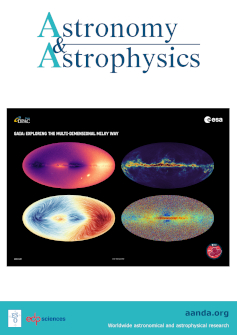Core-collapse supernova parameter estimation with the upcoming Vera C. Rubin Observatory
IF 5.8
2区 物理与天体物理
Q1 ASTRONOMY & ASTROPHYSICS
引用次数: 0
Abstract
The Vera Rubin Observatory's Legacy Survey of Space and Time (LSST) is expected to revolutionize time-domain optical astronomy as we know it. With its unprecedented depth, capable of detecting faint sources down to r∼27.5 mag, the LSST will survey the southern hemisphere sky, generating nearly 32 trillion observations over its nominal 10-year operation. Among these, approximately 10 million will be supernovae (SNe), spanning a wide range of redshifts, with an expected rate of 6.8×10−5 SNe Mpc−3 yr−1. These observations will uniquely characterize the SN population, enabling studies of known and rare SN types, detailed parameterization of their light curves, deep searches for new SN progenitor populations, the discovery of strongly lensed SNe, and the compilation of a large, well-characterized sample of superluminous SNe. We analyzed a sample of 22663 simulations of LSST light curves for core collapse supernovae (CCSNe). The explosions were modeled using the radiative transfer code STELLA, and each event was provided with a value of redshift, extinction, cadence, explosion energy, nickel yield, and progenitor mass. We analyzed this dataset with the software CASTOR, which enables the reconstruction of synthetic light curves and spectra via a machine learning technique that allows one to retrieve the complete parameter map of a SN. For each parameter we compared the observed and the true values, determining how LSST light curves alone will contribute to characterize the progenitor and the explosion. Our results indicate that LSST alone will not suffice for a comprehensive and precise characterization of progenitor properties and explosion parameters. The limited spectral coverage of LSST light curves (in most cases) does not allow for the accurate estimation of bolometric luminosity, and consequently, of the explosion energy and nickel yield. Additionally, the redshift-absorption degeneracy is difficult to resolve without supplementary information. These findings suggest that for the most interesting SNe, complementary follow-up observations using spectrographs and optical facilities (particularly in the infrared bands) will be essential for accurate parameter determination.核心坍缩超新星参数估计与即将到来的维拉C.鲁宾天文台
据我们所知,维拉鲁宾天文台的时空遗留调查(LSST)有望彻底改变时域光学天文学。凭借其前所未有的深度,能够探测到低至r ~ 27.5等的微弱光源,LSST将调查南半球的天空,在其10年的名义运行期间产生近32万亿次观测。其中,大约有1000万颗将是超新星(SNe),跨越了广泛的红移范围,预期速率为6.8×10 - 5 SNe Mpc - 3 yr - 1。这些观测将独特地描绘出SN群的特征,使我们能够研究已知和罕见的SN类型,详细地参数化它们的光曲线,深入搜索新的SN祖先群,发现强透镜SNe,以及编制一个大型的,具有良好特征的超亮SNe样本。我们分析了22663个核心坍缩超新星(CCSNe)的LSST光曲线模拟样本。使用辐射传递代码STELLA对爆炸进行建模,并提供了每个事件的红移值、消光值、节奏值、爆炸能量值、镍产率值和祖质量值。我们用CASTOR软件分析了这个数据集,CASTOR软件可以通过机器学习技术重建合成光曲线和光谱,从而可以检索SN的完整参数图。对于每个参数,我们比较了观测值和真实值,确定LSST光曲线如何单独有助于表征祖星系和爆炸。我们的结果表明,单靠LSST不足以全面而精确地表征祖细胞的性质和爆炸参数。LSST光曲线的有限光谱覆盖范围(在大多数情况下)不允许准确估计热光度,因此,爆炸能量和镍产率。此外,如果没有补充信息,红移-吸收简并很难分辨。这些发现表明,对于最有趣的SNe,使用光谱仪和光学设备(特别是在红外波段)的补充后续观测对于准确确定参数至关重要。
本文章由计算机程序翻译,如有差异,请以英文原文为准。
求助全文
约1分钟内获得全文
求助全文
来源期刊

Astronomy & Astrophysics
地学天文-天文与天体物理
CiteScore
10.20
自引率
27.70%
发文量
2105
审稿时长
1-2 weeks
期刊介绍:
Astronomy & Astrophysics is an international Journal that publishes papers on all aspects of astronomy and astrophysics (theoretical, observational, and instrumental) independently of the techniques used to obtain the results.
 求助内容:
求助内容: 应助结果提醒方式:
应助结果提醒方式:


